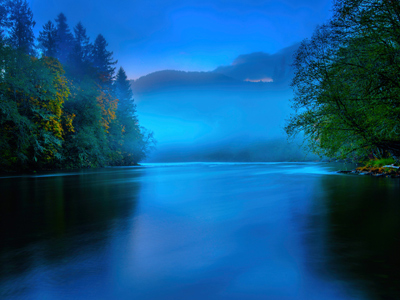
Ask the AI Tutor
Need help with River Movement and Erosion? Ask our AI Tutor!
AI Tutor - Lucy
Connecting with Tutor...
Please wait while we establish connection

How many river terms are you familiar with?
River Movement and Erosion
Rivers are constantly shaping the land, eroding rock, transporting material, and depositing it downstream to create features like waterfalls, meanders, and wide floodplains.
1 .
Where is the flow of the river fastest?
In the upper course
In the middle course
In the lower course
Where it meets the sea
The upper course is the steepest part of the river
2 .
In which part of a river does solution occur?
In the upper course
In the lower course
All the way along the length of the river
Where the river is in contact with soluble materials
The tricky part of this question is deciding between options three and four. Solution could occur all the way along a river, but it will actually only occur at places where the river is in contact with soluble materials. Option three is therefore only partially accurate but option four is completely accurate
3 .
Where in a river valley is lateral erosion dominant?
In the upper course
In the middle course
In the lower course
Where the river goes into the sea or a lake
Slower moving water has less erosional power and can only erode softer materials like the soil of the river banks
4 .
Which of the following correcty describes saltation?
The particles carried by a river are bounced along the river bed
Where a river passes over an area of rock salt, the salt is dissolved by the river water
Boulders falling into the river in the upper course
When an ox-bow lake is formed, the water loses its oxygen and becomes smelly
This occurs to particles that are too large to be kept in suspension
5 .
Which of the following features is an erosional feature of the upper course of a river?
Waterfall
Meander
Delta
Ox-bow lake
They are caused by vertical erosion which is the dominant form of erosion in the upper course of a river
6 .
Hydraulic erosion is caused by:
water washing over the banks of the river during times of flood
large boulders smashing against the banks and bed of the river
decreased pressure where air is trapped in cracks of the river banks and bed
increased pressure where air is trapped in cracks of the river banks and bed
Each time air is trapped and compressed into a crack, the crack can widen, eventually the crack gets large enough to cause part of the bank to break off
7 .
By the time a river is in its lower course, there are no large boulders being carried along. Which of the following could be a reason for this?
Hydraulic action
Abrasion
Attrition
Solution
Make sure that you know the meanings of the four terms in this question. Another reason is that the flow is a lot slower and only fine particles can be moved
8 .
In the introduction to this quiz, we mentioned the processes of abrasion and solution. Look at the following pairs of words. Which pair gives the alternative words that are used to describe the two processes in the order of abrasion and solution?
Corrasion/corrosion
Corrosion/corrasion
Corrasion/collation
Collusion/corrosion
When processes have alternative names, it pays to remember them both
9 .
Which of the following is part of a waterfall?
Meander
Plunge pool
Gorge
Delta
This is the deeper area at the base of the waterfall that has been created by the higher speed of the water at the bottom of the waterfall
10 .
Waterfalls are often created where there is a resistant band of rock that has softer, less resistant rocks above and below. The rocks below are eroded creating an overhang. From time to time the overhang will collapse and so the waterfall gradually move further and further upstream. This is called:
backup
backing
vertical creep
retreat
This happens only very slowly. Niagra Falls is a good example of waterfall retreat
**Unlimited Quizzes Await You! 🚀**
Hey there, quiz champ! 🌟 You've already tackled today's free questions.
Ready for more?
Ready for more?
🔓 Unlock UNLIMITED Quizzes and challenge yourself every day. But that's
not all...
not all...
🔥 As a Subscriber you can join our thrilling "Daily Streak" against other
quizzers. Try to win a coveted spot on our Hall of Fame Page.
quizzers. Try to win a coveted spot on our Hall of Fame Page.
Don't miss out! Join us now and keep the fun rolling. 🎉
**Unlimited Quizzes Await You! 🚀**
Hey there, quiz champ! 🌟 You've already tackled today's free questions. Ready for more?
🔓 Unlock UNLIMITED Quizzes and challenge yourself every day. But that's not all...
🔥 As a Subscriber you can join our thrilling "Daily Streak" against other quizzers. Try to win a coveted spot on our Hall of Fame Page.
Don't miss out! Join us now and keep the fun rolling. 🎉






